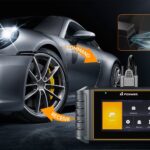Are you looking to monitor your engine’s health and performance using an OBD2 scanner? Understanding knock sensor readings is crucial for any car enthusiast or DIY mechanic. This article dives into how you can access and interpret knock sensor data, often referred to as Knock Retard (KR), through your OBD2 device. We’ll explore popular apps and tools discussed among car owners for effectively monitoring engine knock.
The quest to read knock sensor data via OBD2 is a common one. Many users, especially those driving performance vehicles or those keen on preventative maintenance, want real-time insights into their engine’s combustion process. Knock, or engine detonation, can be damaging over time, and having the ability to monitor your knock sensor can be invaluable.
Several OBD2 applications have emerged as potential solutions for reading knock sensor data. For Android users, Torque Pro is frequently mentioned. While the standard version might not immediately display KR, users have pointed towards add-ons or plugins. One such mention is the “Mazdaspeed pack” for Torque Pro, suggesting it might contain the necessary PIDs (Parameter IDs) to access knock sensor information, even for non-Mazdaspeed vehicles. Another app, “Knock Detector for Torque Pro,” although not readily available on official app stores anymore, highlights the demand for dedicated knock monitoring tools within the Torque Pro ecosystem.
For iPhone users, DashCommand and OBD Fusion are brought into the conversation. While one user reported DashCommand not successfully retrieving KR from a specific vehicle (ND Miata), OBD Fusion is noted as being capable of displaying Knock Retard. This suggests that app compatibility can vary between vehicle models and makes, and experimentation might be needed to find the right combination for your car.
Refresh rate is another important factor when monitoring real-time engine data like knock. A faster refresh rate ensures more granular and immediate feedback. While some users speculated about 100ms refresh rates being necessary for accurate KR measurement, the actual refresh rate is often tied to the vehicle’s ECU and the OBD2 interface’s capabilities. High-quality OBD2 scanners and well-optimized apps will generally provide sufficiently fast data updates for knock monitoring.
In conclusion, reading your engine’s knock sensor via OBD2 is achievable with the right tools and apps. While specific app compatibility and setup might require some investigation based on your vehicle, applications like Torque Pro (with plugins), OBD Fusion, and potentially DashCommand offer pathways to access this valuable engine health data. Monitoring your knock sensor readings empowers you to proactively address potential engine issues, contributing to the longevity and performance of your vehicle.
